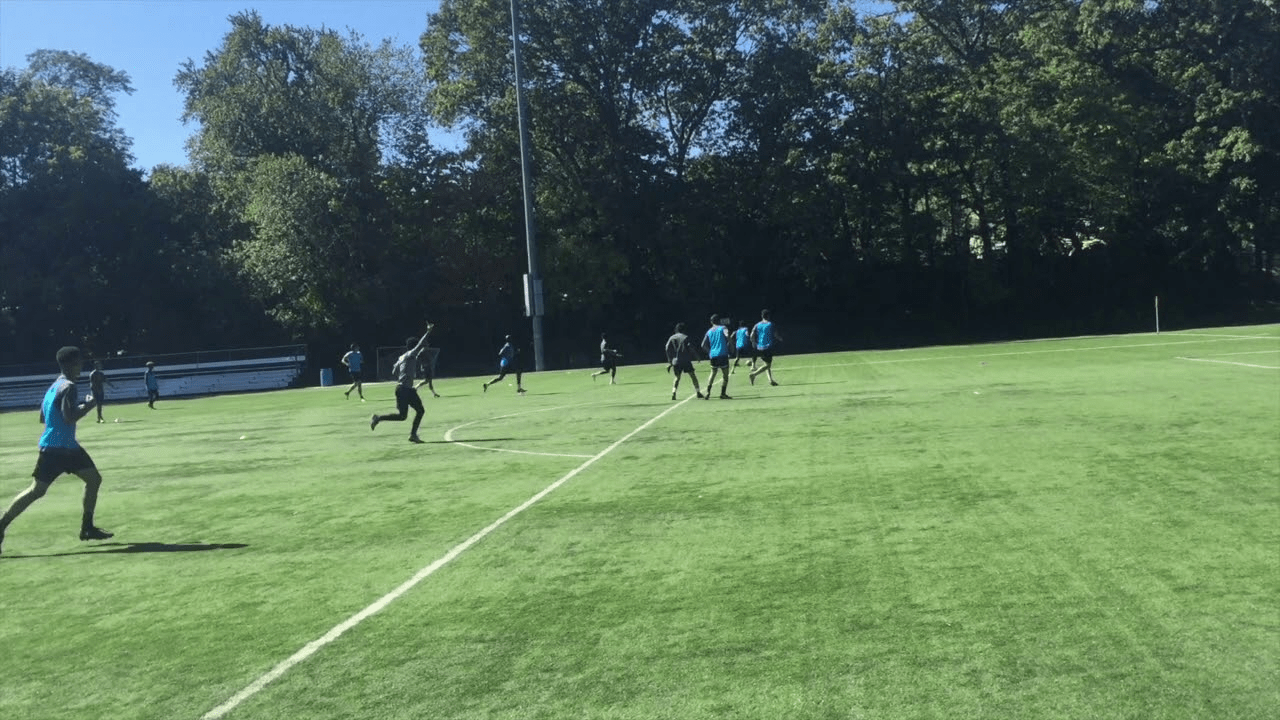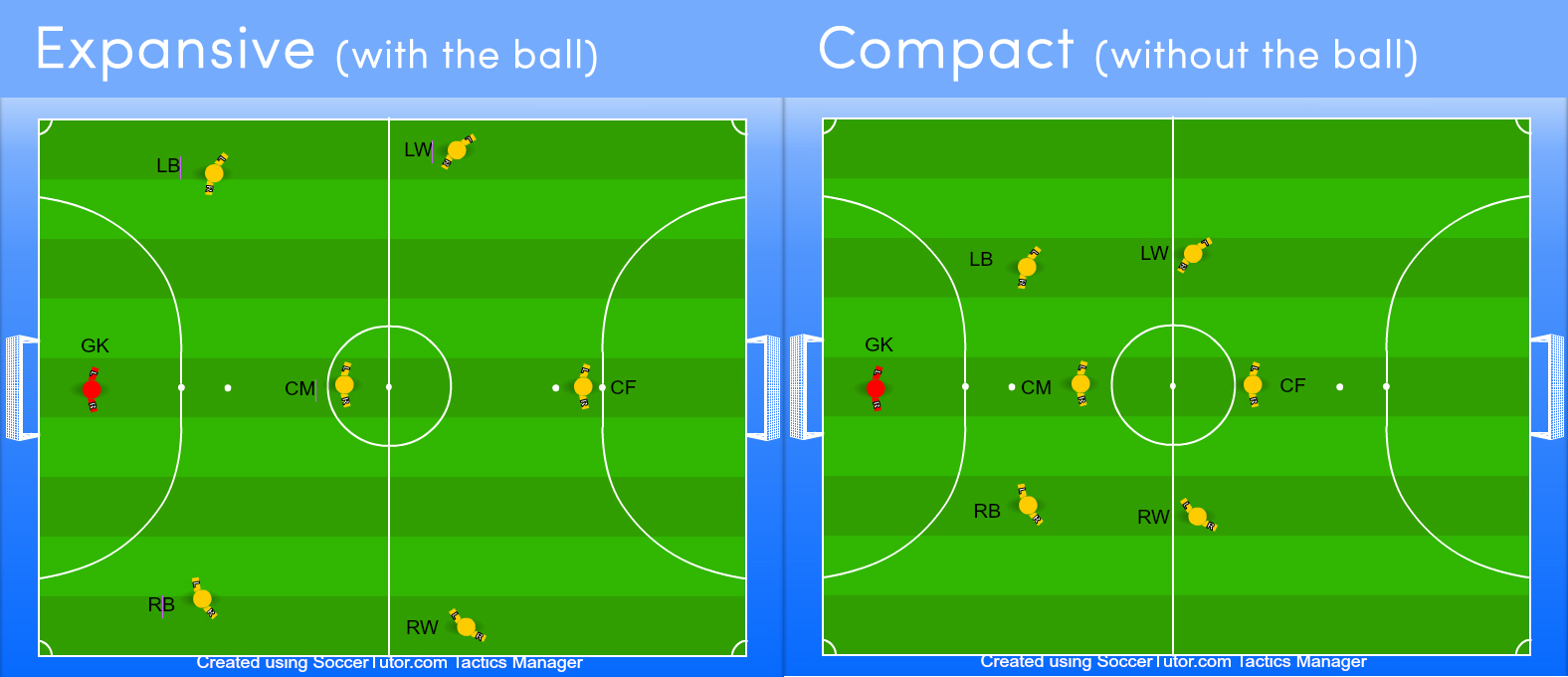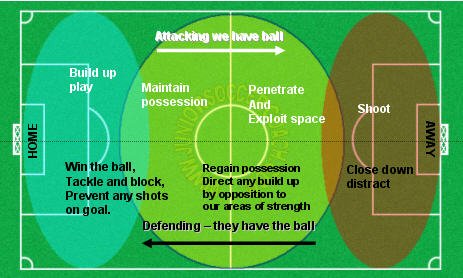
FM19: Frustrating the opposition with defensive width
Defensive width in FM19 is supposed to be self-explanatory. In the FM19 tactics creator, you only get an explanation for the option you pick; you get nothing about what defensive width means in itself. That said, you get a helpful interactive graph:
Don’t the descriptions make it sound like a straightforward choice? Narrow if you want to frustrate your opponents; wide if you want to recover the ball further away from your goal?
This leaves me with a lot of questions. How does the defensive shape react when play switches to one side? Does a wide defensive shape lead to more urgent pressing when you’re up against an opponent on the touchline, and vice versa? Below, I will try to provide as exhaustive a guide as a I can.
Get to the questions already! Defensive width FM19

How does the defensive shape react when play switches to one side?
As the description indicates, the aim of having a wide defensive shape is preventing the opposition from moving the ball into the middle. Therefore, setting your defensive shape to wide can, perhaps counter-intuitively, open up space on the other flank. Here, Hector Bellerin was left entirely free.
The answer doesn’t stop there, though. Like anything, the effects of defensive width depend on the rest of your tactic. Here, my left-back is a defensive wing-back set to sit narrower. It’s true that these factors predominantly affect players in possession. However, when your team engages opponents out wide, they’re attempting to regain possession. It’s surely likely that the lads on the other side of the pitch might be preparing themselves for possession being regained?
Even if that’s not the case, defensive wing-backs are designed to hold their positions and cover when their counterparts maraud forward. At the very least, they’ll close the opposing winger or full-back down less aggressively. As you might’ve noticed, I’m also using a 4-4-2 Diamond Narrow formation; that’s bound to make a difference.
Okay, that makes sense, but what happens when play switches to the side facing your defensive wing-back? – Defensive width FM19
As you can see, your midfielders go and cover. Here, my defensive wing-back was dispossessed on the edge of Arsenal’s penalty box! Defensive width is a team setting. As a general rule, with a wide defensive shape, your players will always engage the opposition out wide when they try their luck, and vice versa.
Here, my defensive wing-back is doing the defending. He’s correctly shifted his position out to the far left. However, he looks a bit isolated, with Pulisic and Bellerin out there. Bellerin’s cutting inside just as that clip finishes! Cautiously, Castro’s backing off slightly, until the box-to-box midfielder ahead of him can support. Despite the gist of how defensive width works never changing, your team’s implementation of it depends on the intricacies of your tactic.
Can you do a better job than the graph in the tactics screen of showing how defensive width affects your general team shape, when the ball’s in the centre?
Certainly.
With a wide defensive shape, we mark the opposing wingers tighter. Keep in mind that I don’t have tight marking set as either a TI or a PI. The two strikers and two centre-backs also split. That said, we haven’t marked the opposing full-backs. It’s worth playing around with your system on 2D, to understand precisely how all the defensive settings are working.
To sum all of this up- Defensive width FM19:
- Wide defensive width suits front-foot pressing, whereas a narrower shape better suits restricting opponents.
- The primary risk with a wide defensive shape isn’t the space in the middle; it’s the open space on the opposite side to the ball.
- A wide defensive shape can be helpful with gegenpressing. If you have two strikers, they’ll both split wide when the opposition have a goal kick. For that reason, having a wide defensive shape should be complemented with aggressive tackling settings.
- The distribution of responsibility in maintaining your team’s defensive width depends on everyone’s role and duty.
- Beware opposition full-backs; having a wide defensive shape only prioritises marking the wingers tighter.
Sam Wilson- Defensive width FM19:
How does formation affect defensive width in FM19?

Of course, there’s no total guideline for the defensive width you should employ in relation to your chosen formation. If it was this easy, we would be able to tell you off the bat which would work best for you. However, there are some ways you can work out whether or not you should play wider or narrower according to your tactics.
Recently, in a save with Lazio, I’ve recreated Simone Inzaghi’s 3-5-1-1, which takes the form of a 5-3-2 within Football Manager. In the past, I’ve always considered playing with a wider defence with a back three. However, this might not always be the best idea.
With just three at the back, wide defensive width can leave huge holes open in your defence. Therefore, unless you have particularly defensive wing-backs on the flank, or other players dropping back to fill any gaps, playing narrow actually creates a strong blockade at the back of your line-up.
A strong defensive midfielder can supplement wide defensive width with a back three. This will, with the right role, mentality and attributes, help plug any gaps caused by the width. The strong tyrant can cover any potential holes in the back line.
Meanwhile, if you’re employing a four-man back line, it may make more logical sense to approach it with standard width but much of this should depend on the competence of your defenders in their given roles.
Adjusting defensive width according to opposition- Defensive width FM19.

One of the most important things to consider with defensive width is adjusting it to suit your needs. Often, the attacking strengths of your opposition should influence any changes you make either prior or during a match. If you’re struggling with an overloaded opposition offence try to adjust during the match. Adjust during the match if the opposition keep catching you out in any event.
Therefore, if you’re using a three-man defence, it’s always worth adjusting your width if you’re coming up against a team with particularly fast wingers. Sticking to narrow could leave holes on either flank, especially if you lack wing-backs with high work rates and defensive attributes. Similarly, playing wide with three defenders against a narrow formation, with strong strikers or a dangerous attacking midfielder, can cause problems. It’s important to keep an eye on your opposition at all times and not to be afraid to switch your defensive width accordingly.
NEW BLOG POST
How to use data to improve your #FM19 save
@FM_Vars walks us through how e's been using attributes to improve struggling Atalanta, with remarkable improvements.#WeAreTheCommunity https://t.co/u9FXKY5ajN pic.twitter.com/QfoN5quYS3— Dictate The Game (@DictateTheGame) August 30, 2019
NEW ARTICLE: Sacked at Stirling. Resigned from Ards and Braintree. Sydney: One last chance.
The Bradshaw saga concludes… will he still be livin’ the dream or will he wake up and the dream will crumble?#WeAreTheCommunity #BlogFMhttps://t.co/2206mgOZXx
— Dictate The Game (@DictateTheGame) August 28, 2019
Why Marseille are the most fun team on Football Manager https://t.co/4RxdfLy4hu pic.twitter.com/5GVYpjJLZM
— Dictate The Game (@DictateTheGame) August 26, 2019
NEW ARTICLE @CrusaderTsar highlights the Sweeper Keeper role in his Running with The Wolves Series#FM19 #WeAreTheCommunity #TheItalianJobFM #BlogFM #AS Roma #AS Roma English https://t.co/LzBhI9DqaA pic.twitter.com/ehO0lOq0vj
— Dictate The Game (@DictateTheGame) August 21, 2019
Football Manager Predicts English Premier League https://t.co/tUJT4GCDSW pic.twitter.com/jTMgtmxiX8
— Dictate The Game (@DictateTheGame) August 19, 2019